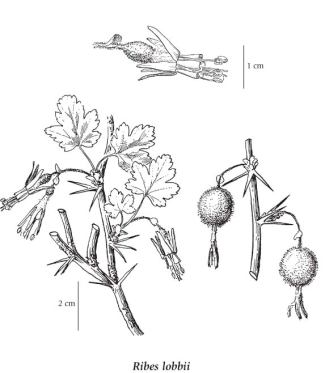Ribes lobbii A. Gray
gummy gooseberry
Grossulariaceae (Currant family)
Introduction to Vascular Plants
gummy gooseberry
Grossulariaceae (Currant family)
Introduction to Vascular Plants
Species Information
General:
Deciduous shrub, loosely branched, 0.5-1 m tall; stems spreading, finely hairy and usually with 3, slender, 7-12 mm long, nodal spines; bark brownish at first, turning deep greyish-red.
Leaves:
Alternate, egg-shaped, shallowly heart-shaped at the base, 1.5-2.5 cm wide, 3-5-lobed less than half their length, the lobes rounded, shallowly cleft and deeply toothed, sparsely hairy or glabrous on the upper surface, more or less hairy and glandular below; stalks equal to or slightly shorter than the blades, glabrous.
Flowers:
Inflorescence of 1-2 flowers in a drooping raceme on stalks shorter than the leaves; flower stalks 1.5-2 mm long, not jointed below the flowers, densely bristly-glandular; petals white or pinkish, broadly fan-shaped, usually inrolled on the edges, 4-6 mm long; hypanthium narrowly bell-shaped, 3.5-5.5 mm long; calyces red, the lobes 10-13 mm long, narrowly oblong, pointed, hairy; styles glabrous, fused to just below or just above the middle, about equaling the stamens.
Fruits:
Berries, round to elliptic, reddish-brown, 12-15 mm long, coarsely bristly-glandular.
Illustration

If more than one illustration is available for a species (e.g., separate illustrations were provided for two subspecies) then links to the separate images will be provided below. Note that individual subspecies or varietal illustrations are not always available.
Illustration Source: The Illustrated Flora of British Columbia
Ecology
Ecological Framework for Ribes lobbii
The table below shows the species-specific information calculated from
original data (BEC database) provided by the BC Ministry of Forests and Range.
(Updated August, 2013)
The table below shows the species-specific information calculated from
original data (BEC database) provided by the BC Ministry of Forests and Range.
(Updated August, 2013)
| Site Information |
Value / Class |
||
|
Avg |
Min |
Max |
|
| Elevation
(metres) |
288 | 212 | 614 |
| Slope
Gradient (%) |
13 | 0 | 70 |
|
Aspect (degrees) |
154 | 45 | 337 |
| Soil
Moisture Regime (SMR) [0 - very xeric; 4 - mesic; 8 - hydric] |
4 | 4 | 5 |
| Modal
Nutrient Regime
Class |
D | ||
| #
of field plots species was recorded in: |
43 | ||
| Modal
BEC Zone Class |
CWH | ||
|
All BEC Zones (# of stations/zone) species was recorded in |
CWH(34) | ||
|
Source:
Klinkenberg 2013
|
|||
Habitat and Range
Mesic to dry streambanks, rock outcrops, open woodlands and forests in the lowland and montane zones; locally frequent on S Vancouver Island and the Gulf Islands; S to CA.Status Information
Synonyms
Synonyms and Alternate Names:
Grossularia lobbii (A. Gray) Coville & Britton